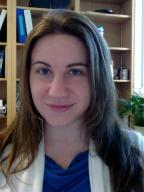
Biography
EDUCATION
Ph.D., Massachusetts Institute of Technology, Cambridge,
MA. B.S. (Chemistry), Temple University, Philadelphia, PA.
POSTDOCTORAL APPOINTMENT
Vanderbilt University, Nashville, TN
COURSES TAUGHT
Chemistry 102, General Chemistry II
Chemistry 102L, General Chemistry II Laboratory
Chemistry 461, Biochemistry I
Chemistry 461L, Biochemistry I Laboratory
Chemistry 462, Biochemistry II
Chemistry 462L, Biochemistry II Laboratory
Chemistry 464, Principles of Biochemistry
Chemistry 464L, Principles of Biochemistry Laboratory
Chemistry 465, Topics in Biochemistry
Chemistry 595D, Topics in Bioinorganic Chemistry
RESEARCH INTERESTS
Biochemistry
The general research interests of the Vey lab lie in protein structure and engineering. We will use X-ray crystallography, bioinformatics and biochemical characterization to elucidate the details of enzyme catalysis, with the long-term goal of modifying target enzymes in a rational manner.
Bacteria carry out many processes that are essential to humans, such as fermentation to produce food and alcohol, synthesis of medically valuable products, and breakdown of pollutants. A thorough understanding of the mechanisms of these processes will allow us to harness the power of these bacteria for biotechnological applications; for example, to design more effective therapeutics, carry out more efficient bioremediation, or develop inexpensive methods for catalysis of industrial chemical reactions.
Our efforts in biotechnology are progressively becoming more sophisticated. Already, well-understood strains of bacteria are being used as mini manufacturing plants, producing important molecules such as insulin for the treatment of diabetes. Genetic engineering efforts are now leading the way towards increasingly complex biotechnological applications, tailoring organisms to highly specific tasks.
Rational design of a metabolic pathway – the combined engineering of the proteins of a biosynthetic pathway and their introduction into a host bacterial strain – has even been used to introduce a small-molecule biosynthetic pathway into E. coli. The implications of rational metabolic engineering are wide-ranging; this type of rational design, with an emphasis on implications in bioremediation and drug development, is our long-term goal. Rational design first requires a complete understanding of the protein of interest, including the atomic structure of that protein. My goal is to advance our collective rational design capabilities by structurally characterizing and analyzing biotechnologically useful enzyme families. I aim to use protein structure, bioinformatics and biochemical characterization to learn about differences between functionally and structurally homologous enzymes that target very different substrates; this knowledge will allow rational and predictable modification of the enzymes. As a starting point for research in my lab, we will attempt to understand the structural determinants for activity of the Class D flavin-containing monooxygenases. New chemical reactivities in this class of enzymes are continually being discovered, and I suspect that this scaffold will prove to be quite useful for biotechnological applications.
PUBLICATIONS (student co-authors indicated with *)
- Gonzalez-Osorio L*, Luong K*, Jirde S*, Palfey BA, Vey JL. "Initial investigations of C4a-(hydro)peroxyflavin intermediate formation by dibenzothiophene monooxygenase." (2016) Biochem. Biophys. Res. Commun. 481(1-2): 189-194.
- Jordan CA*, Sandoval BA*, Serobyan MV*, Gilling D, Groziak MP, Xu HH, Vey JL. "Crystallographic insights into the structure-activity relationships of diazaborine enoyl-ACP reductase inhibitors." (2015) Acta Crystallographica F71, 1521-1530.
- Sartor L*, Ibarra C*, Al-Mestarihi A, Bachmann BO, Vey JL. "X-ray crystal structure of DnmZ, a nitrososynthase in the Streptomyces peucetius anthracycline biosynthetic pathway." (2015) Acta Crystallographica F71: 1205-1214.
- Dowling DP, Vey JL, Croft AK, Drennan CL. “Structural diversity in the AdoMet radical enzyme superfamily.” (2012) Biochim Biophys Acta 1824(11): 1178-1195.
- Vey JL, Drennan CL. “Structural Insights into Radical Generation by the AdoMet Radical Superfamily.” (2011) Chemical Reviews 111(4): 2487-2506.
- Vey JL, Al-Mestarihi A, Hu Y, Bachmann BO, Iverson TM. “Crystal structure of nitrososynthase, a flavin monooxygenase in antibiotic-incorporated nitrosugar biosynthesis.” (2010) Biochemistry 49(43): 9306-9317.
- Vey JL, Yang J, Li M, Broderick JB, Drennan CL. “Structural Basis for Glycyl Radical Formation by Pyruvate Formate-lyase Activating Enzyme.” (2008) PNAS 105(42): 16137-16141.
- Tirupati B, Vey JL, Drennan CL, Bollinger JM. “Kinetic and Structural Characterization of Slr0077/SufS, the Essential Cysteine Desulfurase from Synechocystis sp. PCC 6803.” (2004) Biochemistry 43(38): 12210 – 12219.
- Mascavage LM, Lu Q, Vey JL, Dalton DR, Carroll JR. “Enantioselective Synthesis of Aza Sugars from Amino Acids. 2. The 3-Hydroxy-2-hydroxymethylpyrrolidines.” (2001) Journal of Organic Chemistry 66(10): 3621 – 3626.
M. S. THESES
- Misael Sanchez, 2021: Initial Biochemical Characterization of Flavin Dependent Monooxygenase DszA, From the Rhodococcus Biodesulfurization Pathway
- Samatar Jirde, 2018: A Kinetic and Thermodynamic Investigation into Catalysis by Dibenzothiophene Monooxygenase
- Kellee Eberle (Johnson), 2018: Investigating Amino Acid Residues in the Active Site of Dibenzothiophene Monooxygenase
- Liliana Gonzalez-Osorio, 2017: Initial biochemical characterization of dibenzothiophene monooxygenase by steady state and transient state kinetics
- Casper Wong, 2017: Battling Antibiotic Resistance by Investigation of Acinetobacter baumannii Enoyl Acyl Carrier Protein Reductase
- Charmaine Ibarra, 2015: Initial Study of Isobutylamine N-Hydroxylase (vlmH), an Enzyme in the Valanimycin Biosynthetic Pathway
